September 8, 2015
Posted in 2015 Minidoka Pilgrimage, Minidoka, Minidoka Pilgrimage tagged 2015 Minidoka Pilgrimage, Executive Order 9066, Japanese American Incarceration, Minidoka, Minidoka National Historic Site, Minidoka Pilgrimage, Pilgrimage at 5:23 pm by minidokapilgrimage
http://www.napost.com/2015/08/13/minidoka-pilgrimage-throws-new-mission-to-youger-generations/
By Fumika Iwasaki
The North American Post
The 11th annual Minidoka Pilgrimage was held from June 25 to June 28, and I joined the event as a scholarship recipient of the committee. On the four-day tour, about 200 participants had the chance to visit Minidoka National Historic Site, a former Japanese American incarceration camp site, and to hear stories from those who were incarcerated, researchers and activists.
This year marked the 70th anniversary of the ending of World War II. People who can share firsthand experiences of incarceration are aging, and their number has been decreasing every year.
In this pilgrimage, the great majority of pilgrims were in their 70s or 80s and actually experienced World War II or in their 40s or 50s with parents or relatives who were incarcerated. Meanwhile, about 10% of participants were younger than 30.
Youth had a chance to gather in a session on the second day and discuss and share their thoughts on the pilgrimage, reasons to participate in the pilgrimage this year and how to preserve the history for the next generation.
Preserving history is not easy.
“My grandmother and grandfather were incarcerated, but they did not want to talk about it,” one said, while others added, “My grandmother and grandfather already passed away so I cannot hear about it.”
In Japan, there are usually few chances to learn about Japanese American history. But surprisingly, I also realized that pilgrimage participants told me that some American text books cover Japanese American history in only half a page.
This pilgrimage has significant meaning because youth can visit a historic site and hear about experiences and research of the Japanese American incarceration.
“They had only one room per family, so they had no privacy except in the bathroom,” one speaker said in the legacy session of the pilgrimage program.
Their housing situation was extremely bad as they suffered from dust because of cracks in the floors of the barracks. As all pilgrims experienced, the summer is hot and heavy snows comes in the winter.
But through this tour, I also learned about efforts to make incarceration camps active and livable. As Kay Sakai Nakao said, “Through the negatives, a lot of positives happened,” the Nikkei in the incarceration camp lived with more than sadness. The documentary shown in the educational session shared stories of their making furniture and toys for Christmas.
“Near my house, there still remained a custom that older people took care of younger people, so older people made toys for me,” said Kanji Sahara.
In the warehouse site at the Minidoka National Historical Site, a National Park Service guide said, “From the second year of incarceration, people exchanged food amongst themselves to eat more varieties of food.”
Still, the historic and unjust experiences cannot be changed.
“Some people were put in jail without proper process,” said Harriet Miyasato Beleal. “We have so many civil rights.”
When Japanese people who live in Japan hear about compulsory interment during World War II, they might think of concentration camps such as Auschwitz. For Japanese Americans however, there were no compulsory labor or genocide, but they were forced to leave their homes, and some of them were sent to jail unconditionally. Regardless of homeland or race, to prevent racial discrimination like compulsory internment, we have to learn about history as a problem of human rights.
“We are looking for Sansei and Yonsei to tell the story we heard this pilgrimage,” said Don Shimono, a Minidoka Pilgrimage committee member.
It depends on the next generation to keep the history of incarceration in people’s memories. As one of them, I have been questioning myself after this pilgrimage.
Permalink
February 24, 2015
Posted in 2015 Minidoka Pilgrimage, Friends of Minidoka, Japanese American Incarceration, Minidoka, Minidoka Pilgrimage, News tagged 2015 Minidoka Pilgrimage, Executive Order 9066, Japanese American Incarceration, Minidoka, Minidoka National Historic Site, Minidoka Pilgrimage, Pilgrimage, Registration at 9:30 am by minidokapilgrimage
Press Release – For Immediate Release
2015 Minidoka Pilgrimage June 25 – June 28, 2015
Announcing the 13th Annual Minidoka Pilgrimage
Seattle, WA – February 24, 2015 –
The Minidoka Pilgrimage Planning Committee announces the 2015 pilgrimage dates are Thursday, June 25 through Sunday, June 28, 2015.
In 1942, almost 13,000 people of Japanese-ancestry living in Washington and Oregon, many of whom were American citizens, were removed from their homes and sent to a desolate “concentration camp” near Twin Falls, Idaho. This summer, the 13th pilgrimage will take place with former incarcerees, their families, and friends – from Seattle, Portland and across the nation – to the former Minidoka Camp in Idaho. This is an opportunity to learn, share memories, and ask questions about the Minidoka experience. Consider participating as a way to bring your family together and reconnect with friends. Participation is limited.
The Minidoka Pilgrimage officially begins in Twin Falls, Idaho on Thursday evening, June 25, for dinner. On Friday, this year will feature a full day of educational programming. On Saturday, the group tours the Minidoka National Park Site followed with small group discussions to learn and share experiences of the incarceration experience. On Sunday morning, we will conclude our pilgrimage with a commemorative closing ceremony at Minidoka National Park Site.
Pilgrimage Details
Registration forms and additional information for the pilgrimage can be found at www.minidokapilgrimage.org.
There are two different registration packages:
· The Seattle/Bellevue package includes bus transportation from Bellevue, Washington to Twin Falls, Idaho. The registration fee is $400.00.
· The Boise/Twin Falls Package requires participants to provide their own transportation to Twin Falls, Idaho. The price is $200.00. **There is a discount on both packages for children under 12 and seniors 75 years and older.
The registration fee includes meals and all activities during the pilgrimage. Lodging must be made by each participant. Please review the Hotel and Information document and the Registration Form for more information on Pilgrimage packages (Seattle and Twin Falls). This information can be found on the Minidoka Pilgrimage web site at: www.minidokapilgrimage.org.
The Minidoka Pilgrimage Planning Committee is excited to once again offer a SENIOR SCHOLARSHIP for those who are over 80 years of age and were imprisoned in any of the American concentration camps during WWII. Please review the Senior Scholarship Registration Form to apply for the scholarship.
All forms and information can be found on the Minidoka Pilgrimage website at: www.minidokapilgrimage.org.
For other questions or concerns, please feel free to contact us at minidokapilgrimage@gmail.com.
For those who cannot access the forms and information by computer, please leave your name and address with Dale H Watanabe at 206-296-6260 and they can be mailed to you.
Contact: Dale H Watanabe
(206) 296-2156
watanad@seattleu.edu
###
Permalink
October 13, 2014
Posted in Japanese American Incarceration, Minidoka, News tagged Executive Order 9066, Henry Miyatake, Japanese American Incarceration, Minidoka, Minidoka National Historic Site, Minidoka Pilgrimage, Redress at 11:25 am by minidokapilgrimage
http://www.iexaminer.org/2014/10/henry-miyatake-a-man-with-the-plan/
Remembering Henry Miyatake: A man with the plan
BOB SHIMABUKURO OCTOBER 13, 2014

History demands that the person who gave birth to an idea must be recognized when it reaches maturation.
—Washington Supreme Court Justice Charles Z. Smith, on Henry Miyatake, 1997
A one-liner from the October 3 edition of the Auburn (Washington) Reporter reported under “Deaths:”
Miyatake, Henry, 85, September 16.
That’s it.
After all he did for the Japanese American community and everyone who was affected by E.O. 9066, which means all of us residing in the United States, he gets a one-liner in the County Register. I shed a few tears over that thought. And then I wrote:
“Great man, restless mind
Died alone, apparently;
Maybe he wanted it that way.
RIP, Henry.”
I couldn’t think of anything more to write.
* * *
Later, I remembered half-promises to him.
“Bob,” Henry said about 3-to-4 years ago, “you haven’t finished writing about the Internment.”
“Yes, I have,” I said.
“No you haven’t,” he answered, handing me a book. “You’ve got to read this. You’ll see what I’m talking about.”
I looked at it. Day of Deceit: The Truth About FDR and Pearl Harbor, by Robert D. Stinnett. I thought, “Oh no, not another book about Magic Cables and stuff like that. What’s Henry doing reading this kind of crap?”
He must have read my mind. “Just read it, Bob,” he said. “It’s the real story of United States getting into the war. And why we ended up in the camps.”
“But it’s not my kind of reading,” I said. “It’s all words, numbers, and people’s names. Lots and lots of description. No dialogue. Tough to follow. My mind drifts too much.”
Henry made me promise that I’d take a look at the book. I did. And I knew why it consumed him. But after slogging through five-to-six chapters of the book, I was asking myself, do I really want to write anything on this?
I figured out what got Henry’s attention. Stinnett was making the case that President Franklin Roosevelt knew of Japan’s plans to bomb Pearl Harbor, but he wanted to let it happen in order to unite the country into entering the war and, perhaps, even incarcerating us.
But I really didn’t see any reason to pursue a book, let alone finish Day of Deceit. Whether we were pawns in FDR’s political battles or the entire country’s scapegoat for the war made no difference to me. In the end the President, Supreme Court, Congress, and every U.S. citizen shoulder the responsibility. They all used us for pawns in their game in which people who can be identified by their looks and appearances may be sacrificed without regard to the laws written on the books. No different than what is happening now.
But I just couldn’t tell Henry that I wasn’t interested. Because he was a very persistent guy. And then I’d end up making a promise I never would keep, … as opposed to only a half-promise. So I avoided giving him his book back. And I’ve felt bad every time I see this book in my house. It’s too late now to give it back.
For those who don’t know about Henry’s historic achievements, he was the “Man with THE Plan,” the Seattle Plan for redress. In November 1979, Congressman Mike Lowry introduced the first redress bill for the 120,000 Japanese Americans who were incarcerated for no reason other than their ancestry under the guise of “military necessity.” Henry’s plan was the basis for that bill.
Henry did a lot of research, pitched his plan to his friend, Mike Nakata, who talked to his friend Shosuke Sasaki, and all of them started talking to community members and organizations, including nationalJapanese American Citizens League, and reached out to the remotest parts of the country to gather enough votes in Congress to redress a wrong.
This 20-year organizing campaign, ending in the 1990s when payments of $20,000 went to individuals who were incarcerated or forcibly evicted from where they were living is one of the most remarkable stories of the 20th century.
I asked some of the younger folks in the community if they had heard about Henry Miyatake who had just died last month. Too many of those I asked did not know who he was. I felt sad once again.
So I can’t let this rest. There are a lot more stories about Henry Miyatake. In a month or two or even three, we will have a memorial service for Henry. All of us who knew Henry should get together with those who did not know Henry and what he did for everyone who who cares about democracy and everyone who takes it for granted.
Watch for notice of it. We need this, whether we know it or not.
I, along with Tom Ikeda of Densho, Japanese American Citizens League Seattle Chapter, Nisei Veterans Committee and other individuals and organizations will be working on a memorial service for Henry. More information will follow in the coming weeks.
Bob Shimabukuro is the author of “Born in Seattle: The Campaign for Japanese American Redress.”
*UPDATE: COMMUNITY MEMORIAL EVENT FOR HENRY MIYATAKE*
There will be a community memorial event for redress activist Henry Miyatake on Saturday, December 6, 2014, at NVC Memorial Hall, 1212 S King Street, Seattle, WA 98144. A pre-event social, with light refreshments, will begin at 1:00 PM. The memorial program will be from 2:00-3:00 PM.
Permalink
August 5, 2014
Posted in 2014 Minidoka Pilgrimage, Japanese American Incarceration, Minidoka, Minidoka Pilgrimage, News tagged 2014 Minidoka Pilgrimage, Dana Mar, Executive Order 9066, Guard Tower, Japanese American Incarceration, Minidoka, Minidoka National Historic Site, Minidoka Pilgrimage, pictures at 10:39 am by minidokapilgrimage
Memories Revisited on the Minidoka Pilgrimage
by Dana Mar
 Photo by: Dana Mar
Photo by: Dana Mar
Heartfelt stories and hopes for the future were shared on the annual pilgrimage to the Minidoka incarceration camp from this past June 19 through the 22nd. Over the course of these few days, pilgrims—a vast majority of whom were from Washington and Idaho—traveled to gather in Twin Falls, Idaho to commune with one another over the subject of Minidoka and the current-day application of the consequences of the incarceration of so many Japanese and Japanese Americans.
Still full of energy, many of the Nisei revisited memories during the pilgrimage of their time in camp and imparted stories of life seventy years ago when President Roosevelt issued Executive Order 9066, effectively removing Japanese and Japanese Americans from the majority of the West Coast. Some flew with multiple generations of family, while others braved the long bus ride, incidentally turning out to be more of an adventure than half the Seattle pilgrims expected as one of the buses unexpectedly broke down. Difficulties of the drive aside, yet incomparable to the experience of those bussed to Minidoka in the 1940s, it provided time for pilgrims to get to know each other and seek out old friends.
 Tetsuden and Kanako Kashima standing next to the 2014 Pilgrimage Momento at the Closing Ceremony
Tetsuden and Kanako Kashima standing next to the 2014 Pilgrimage Momento at the Closing Ceremony
Photo by: Dana Mar
This year, the Minidoka Pilgrimage held an educational program on the second day rather than a trip to the Civil Liberties Symposium. The session featured several notable speakers and presenters including opening remarks by Yosh Nakagawa, and sessions held three at a time following presented by Rev. Brooks Andrews, Dr. Neil Nakadate, Dr. Lawrence Matsuda, and more. In addition, the Pilgrimage provided genealogy workshops run by Minidoka Pilgrimage Planning Committee members Stephen Kitajo and Bif Brigman, a film screening of Kash, directed by Vince Matsudaira, and the Minidoka Collections Tour held in previous years. The educational sessions turned out as quite a success and allowed a great variety of opportunities to listen, learn, and ask questions on subjects regarding Minidoka and the many aspects varying groups and individuals brought to the Pilgrimage.
As it was when I first attended the pilgrimage last year, the pilgrims bussed to the Minidoka site itself for a tour of the grounds upon which they were allowed to view and experience a number of returned and still standing original structures from the grounds and block 22, as well as, for the very first time, see the newly built historically accurate guard tower, constructed thanks to generous donations to the Friends of Minidoka who managed the project. Where trains and buses dropped families upon families of those defined by their Japanese heritage and “the wind swirled dust clouds,/ghosts of Minidoka wandering the land” as Lawrence Matsuda read aloud during his session on Friday, memories were unstuck from their place behind gaman. The experience of desolation, sadness, wind, heat, and sheer distance one must walk to get from one location to another gave just a small sense of what life was like for all the Issei and Nisei incarcerated there.
 Pilgrims walking towards the site of Block 22, where an original mess hall and barrack sit
Pilgrims walking towards the site of Block 22, where an original mess hall and barrack sit
Photo by: Dana Mar
We remembered the great hardships the Issei had to go through in being imprisoned in a foreign nation and regarded as dangerous enemies despite having shown no indication of the sort. As the few remaining Nisei shared their stories and thoughts in the subsequent talk story session wherein pilgrims were split into smaller discussion groups, I recalled the words repeated to me so many times before, “Nidoto nai yoni.” In the words of Vince Matsudaira just after the showing of Kash,
 Pilgrims walking by an original barrack building on Block 22
Pilgrims walking by an original barrack building on Block 22
Photo by: Dana Mar
“people forget, history forgets, so, you know, I think we can all make our marks somewhere. …Each of us know, like, a hundred people so that keeps spreading out and spreading out, but unless it keeps going it’ll die.”
Accounts of fond memories and reminiscences of bitterness and healing from those who were in the camps were passed on from families and pilgrims previously incarcerated to those who needed to know what a grandmother never shared or how precisely did an incident occur or even what it felt like to be in the shoes of the unjustly persecuted generations of the past. It was both a sobering and heartwarming experience that one truly must be present on the pilgrimage to experience. It was an amazing experience one is not likely to forget and, as so much of the memories are being lost as time passes, ought not to for how valuable these first and even second-hand accounts are for younger and future generations to know of.
 Presentation of the Colors by American Legion Post #41, Wendell, ID
Presentation of the Colors by American Legion Post #41, Wendell, ID
Photo by: Dana Mar
The Minidoka Pilgrimage Planning Committee and this year’s student scholarship recipients did such outstanding work for this year’s pilgrimage, deemed the “year of the guard tower,” and is in deserving of much thanks and appreciation. The pilgrimage has served for years to As we work to commemorate generations past and educate others about the deeper meaning of the camps and the incarceration, we hold high hopes for future generations to carry on the legacy of the Issei and Nisei.
 Pilgrims waiting for the ribbon cutting ceremony of the newly reconstructed guard tower
Pilgrims waiting for the ribbon cutting ceremony of the newly reconstructed guard tower
Photo by: Dana Mar
Permalink
July 30, 2014
Posted in 2014 Minidoka Pilgrimage, Japanese American Incarceration, Minidoka, Minidoka Pilgrimage, News, Photos, Uncategorized tagged 2014 Minidoka Pilgrimage, Dana Mar, Eugene Tagawa, Executive Order 9066, Japanese American Incarceration, Minidoka, Minidoka National Historic Site, Minidoka Pilgrimage, pictures, Ryan Kozu at 4:48 pm by minidokapilgrimage
Here’s links to various sites where pictures from the 2014 Minidoka Pilgrimage have been posted!
Feel free to browse and use for your own personal usage but if you wish to use pictures for commercial purposes please contact us at: minidokapilgrimage@gmail.com for more information.
Ryan Kozu:
https://picasaweb.google.com/103180039956765998297/MinidokaPilgrimage2014?authuser=0&authkey=Gv1sRgCJ7Pxp7Wm9vVEQ&feat=directlink
Dana Mar:
https://picasaweb.google.com/minidokapilgrimage/2014MinidokaPilgrimageDana?authuser=0&feat=directlink
Eugene Tagawa:
https://picasaweb.google.com/100930662448489700454/2014MinidokaPilgrimageGroupsL?authkey=Gv1sRgCLuK1-3l-vSb3wE&noredirect=1
Permalink
June 30, 2014
Posted in 2014 Minidoka Pilgrimage, Friends of Minidoka, Japanese American Incarceration, Minidoka, Minidoka Pilgrimage, Photos tagged 2014 Minidoka Pilgrimage, Eugene Tagawa, Executive Order 9066, Japanese American Incarceration, Minidoka, Minidoka National Historic Site, Minidoka Pilgrimage, pictures at 9:55 am by minidokapilgrimage
Here are some of the large group pictures from the 2014 Minidoka Pilgrimage.
Photo Credit: Eugene Tagawa

2014 Minidoka Pilgrimage Participants
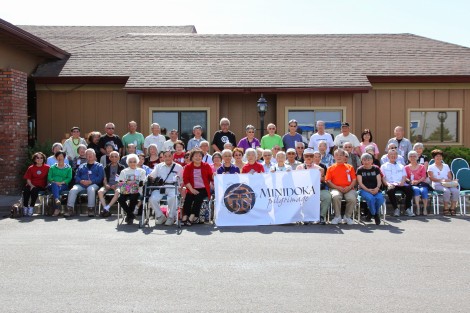
Everyone who was incarcerated in Camp
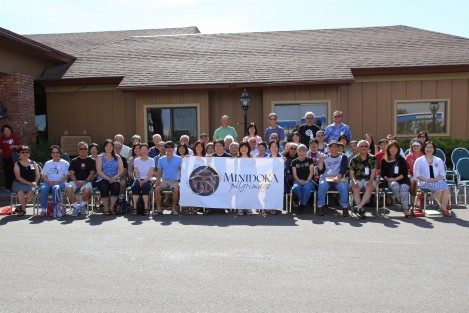
Sanseis
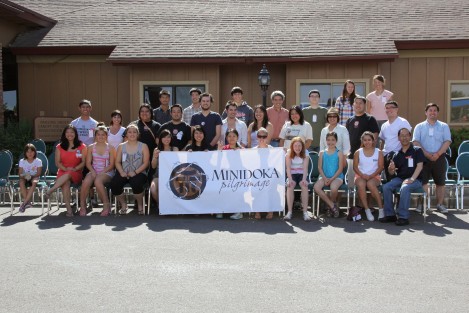
Yonsei/Gonsei

Hapas

2014 Minidoka Pilgrimage Planning Committee
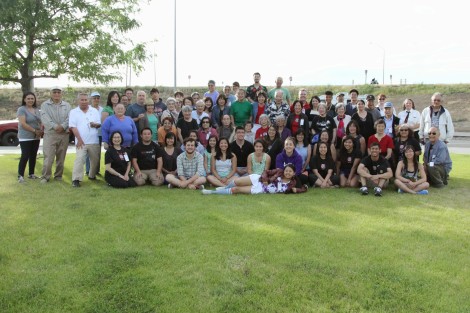
2014 Seattle Bus Riders
Permalink
June 3, 2014
Posted in Japanese American Incarceration, Minidoka, Minidoka Pilgrimage, News tagged 2013 Minidoka Pilgrimage, Day of Remembrance, Executive Order 9066, Japanese American Incarceration, Magic Valley Times, Minidoka, Minidoka National Historic Site, Minidoka Pilgrimage at 9:55 am by minidokapilgrimage
http://magicvalley.com/news/local/visitor-center-planned-for-minidoka-national-historic-site/article_feed3a24-e625-11e3-878f-001a4bcf887a.html
Visitor Center Planned for Minidoka National Historic Site
EDEN • The Minidoka National Historic Site near Eden was an internment camp established during World War II where approximately 13,000 Japanese-American internees were detained. Now, through the National Park Service, the old Minidoka Relocation Center will be receiving a brand new visitor center to tell the story of the hardships of Japanese-Americans held there.
On February 19, 1942, President Franklin D. Roosevelt issued Executive Order 9066. The order authorized the Secretary of War to exclude any persons from designated areas as a national security measure. According to Carol Ash, chief of interpretation and education for the National Park Service at Hagerman Fossil Beds and Minidoka, nearly 120,000 people of Japanese ancestry were rounded up along the Pacific Coast following Dec. 7, 1941 attack on Pearl Harbor and placed into internment camps throughout the country.
In addition to a new staffed visitor center at the site in Eden, some of the camp’s original buildings will be rehabilitated to provide a better perspective of life while imprisoned there. Exhibits detailing the incarceration experience will be built and a public reflection area will also be available where visitors to the site can record their feelings about the camp.
“There were government reports that said they (Japanese-Americans) were no threat to their country during WWII,” Ash said. “After the war was over there was not one single documented case of sabotage by the Nisei, by the Japanese. It truly, truly was a civil liberties issue and that’s what makes these sites so very important.”
Ash also said that an oral history area will be on-site and contain audio of camp internees talking about their experiences. Ash hopes that a new visitor’s center at the site will help better educate and illustrate the importance of remembering what happened. Ash said that plans are moving Planning for the new visitor’s center began in April and it will hopefully completed by 2017, Ash said.
“We call it a site of conscience,” said Ash of the Minidoka site. “Two thirds of those people were American citizens. There was no due process of any kind and they were forcibly removed from their homes.”
The internees were sent to detention centers where they stayed for months until the relocation centers were built. From 1942 to 1945, the internment camps would be home to American citizens because of widespread paranoia following Japan’s attack on Pearl Harbor.
“They spent three years in prison,” Ash said. “With no due process it becomes a civil liberties issue and that’s why it’s so critical that we remember that.”
Permalink
March 20, 2014
Posted in 2014 Minidoka Pilgrimage, Japanese American Incarceration, Minidoka, Minidoka Pilgrimage, News tagged 2014 Minidoka Pilgrimage, Japanese American Incarceration, Minidoka, Minidoka National Historic Site, Minidoka Pilgrimage, Registration at 9:05 am by minidokapilgrimage
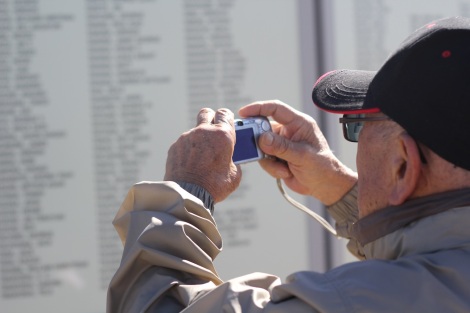
Registration for the 2014 Minidoka Pilgrimage is now open. Registration can either be done online or via mail.
Links:
2014 Minidoka Pilgrimage Information Page: https://minidokapilgrimage.wordpress.com/2014-minidoka-pilgrimage-information-page/
Online Registration: http://minidokapilgrimage2014.bpt.me/
2014 Minidoka Pilgrimage Registration Form: http://www.minidokapilgrimage.org/2014_Minidoka_Pilgrimage_Registration_Form.pdf
2014 Senior Scholarship Form: http://www.minidokapilgrimage.org/2014_Senior_Registration_Form.pdf
Information and Hotel Info Sheet: http://www.minidokapilgrimage.org/2014_Information_and_Hotel_Info_Sheet__1_.pdf
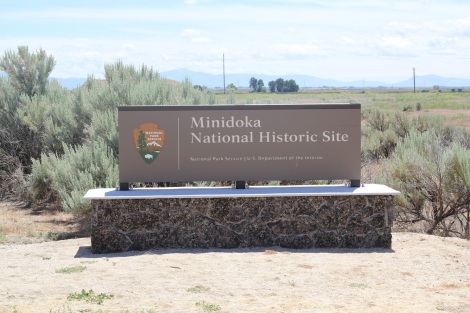


Permalink
Posted in 2014 Minidoka Pilgrimage, Friends of Minidoka, Honor Roll, Japanese American Incarceration, Minidoka, Minidoka Pilgrimage, News tagged 2014 Minidoka Pilgrimage, Executive Order 9066, Japanese American Incarceration, Minidoka, Minidoka National Historic Site, Minidoka Pilgrimage, Pilgrimage, Registration at 9:02 am by minidokapilgrimage

Press Release – For Immediate Release
2014 Minidoka Pilgrimage
June 19 – June 22, 2014
Announcing the 12th Annual Minidoka Pilgrimage and the 72nd Anniversary of the signing of Executive Order 9066
Seattle, WA – March 4, 2014
The Minidoka Pilgrimage Planning Committee announces the 2014 pilgrimage dates are Thursday, June 19 through Sunday, June 22, 2014.
Registration forms and additional information for the pilgrimage can be found at www.minidokapilgrimage.org.
There are two different registration packages:
• The Seattle/Bellevue package includes bus transportation from Bellevue, Washington to Twin Falls, Idaho. The registration fee is $385.00.
• The Boise/Twin Falls Package requires participants to provide their own transportation to Twin Falls, Idaho. The price is $185.00. **There is a discount on both packages for children and seniors 75 years and older.
The registration fee includes meals and all activities during the pilgrimage. Lodging must be made by each participant. Please review the Hotel and Information document and the Registration Form for more information on Pilgrimage packages (Seattle and Twin Falls). This information can be found on the Minidoka Pilgrimage web site at www.minidokapilgrimage.org.
Pilgrimage Details
In 1942, almost 13,000 people of Japanese-ancestry living in Washington and Oregon, many of whom were American citizens, were removed from their homes and sent to a desolate “incarceration camp” near Twin Falls, Idaho. This summer, the 12th pilgrimage will take place with former incarcerees, their families, and friends – from Seattle, Portland and across the nation – to the former Minidoka Camp in Idaho. This is an opportunity to learn, share memories, and ask questions about the Minidoka experience. Consider participating as a way to bring your family together and reconnect with friends. Participation is limited.
The Minidoka Pilgrimage officially begins in Twin Falls, Idaho on Thursday evening, June 19, for dinner. On Friday, this year will feature a full day of educational programming. On Saturday, the group tours the Minidoka National Park Site followed with small group discussions to learn and share experiences of the incarceration experience. On Sunday morning, we will conclude our pilgrimage with a commemorative closing ceremony at Minidoka National Park Site.
The Minidoka Pilgrimage Planning Committee is excited to once again offer a SENIOR SCHOLARSHIP for those who are over 80 years of age and were imprisoned in any of the American concentration camps during WWII. Please review the Senior Scholarship Registration Form to apply for the scholarship.
All forms and information can be found on the Minidoka Pilgrimage website at www.minidokapilgrimage.org.
For other questions or concerns, please feel free to contact us at minidokapilgrimage@gmail.com.
For those who cannot access the forms and information by computer, please leave your name and address with Dale H Watanabe at 206-296-6260 and they can be mailed to you.
Contact: Dale H Watanabe
(206) 296-6260
watanad@seattleu.edu
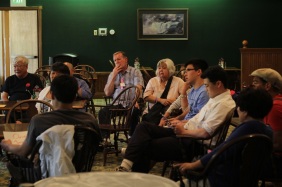
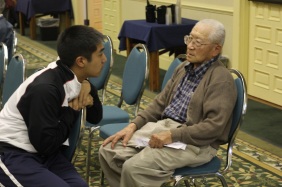

Permalink
Next page


 Photo by: Dana Mar
Photo by: Dana Mar Tetsuden and Kanako Kashima standing next to the 2014 Pilgrimage Momento at the Closing Ceremony
Tetsuden and Kanako Kashima standing next to the 2014 Pilgrimage Momento at the Closing Ceremony Pilgrims walking towards the site of Block 22, where an original mess hall and barrack sit
Pilgrims walking towards the site of Block 22, where an original mess hall and barrack sit Pilgrims walking by an original barrack building on Block 22
Pilgrims walking by an original barrack building on Block 22 Presentation of the Colors by American Legion Post #41, Wendell, ID
Presentation of the Colors by American Legion Post #41, Wendell, ID Pilgrims waiting for the ribbon cutting ceremony of the newly reconstructed guard tower
Pilgrims waiting for the ribbon cutting ceremony of the newly reconstructed guard tower

















